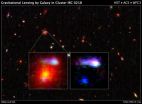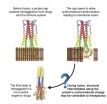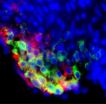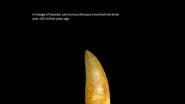(Press-News.org) Astronomers using NASA's Hubble Space Telescope have unexpectedly discovered the most distant galaxy that acts as a cosmic magnifying glass. Seen here as it looked 9.6 billion years ago, this monster elliptical galaxy breaks the previous record-holder by 200 million years.
These "lensing" galaxies are so massive that their gravity bends, magnifies, and distorts light from objects behind it, a phenomenon called gravitational lensing. Finding one in such a small area of the sky is so rare that you would normally have to survey a region hundreds of times larger to find just one.
The object behind the cosmic lens is a tiny spiral galaxy undergoing a rapid burst of star formation. Its light has taken 10.7 billion years to arrive here and seeing this chance alignment at such a great distance from Earth is a rare find. Locating more of these distant lensing galaxies will offer insight into how young galaxies in the early universe build themselves up into the massive dark-matter-dominated galaxies of today. Dark matter cannot be seen, but it accounts for the bulk of the universe's matter.
"When you look more than 9 billion years ago in the early universe, you don't expect to find this type of galaxy lensing at all," explained lead researcher Kim-Vy Tran of Texas A&M University in College Station. "It's very difficult to see an alignment between two galaxies in the early universe. Imagine holding a magnifying glass close to you and then moving it much farther away. When you look through a magnifying glass held at arm's length, the chances that you will see an enlarged object are high. But if you move the magnifying glass across the room, your chances of seeing the magnifying glass nearly perfectly aligned with another object beyond it diminishes."
Team members Kenneth Wong and Sherry Suyu of Academia Sinica Institute of Astronomy & Astrophysics (ASIAA) in Taipei, Taiwan, used the gravitational lensing from the chance alignment to measure the giant galaxy's total mass, including the amount of dark matter, by gauging the intensity of its lensing effects on the background galaxy's light. The giant foreground galaxy weighs 180 billion times more than our sun and is a massive galaxy for its time. It is also one of the brightest members of a distant cluster of galaxies, called IRC 0218.
"There are hundreds of lens galaxies that we know about, but almost all of them are relatively nearby, in cosmic terms," said Wong, first author on the team's science paper. "To find a lens as far away as this one is a very special discovery because we can learn about the dark-matter content of galaxies in the distant past. By comparing our analysis of this lens galaxy to the more nearby lenses, we can start to understand how that dark-matter content has evolved over time."
The team suspects the lensing galaxy continued to grow over the past 9 billion years, gaining stars and dark matter by cannibalizing neighboring galaxies. Tran explained that recent studies suggest these massive galaxies gain more dark matter than stars as they continue to grow. Astronomers had assumed dark matter and normal matter build up equally in a galaxy over time, but now know the ratio of dark matter to normal matter changes with time. The newly discovered distant lensing galaxy will eventually become much more massive than the Milky Way and will have more dark matter, too.
Tran and her team were studying star formation in two distant galaxy clusters, including IRC 0218, when they stumbled upon the gravitational lens. While analyzing spectrographic data from the W.M. Keck Observatory in Hawaii, Tran spotted a strong detection of hot hydrogen gas that appeared to arise from a giant elliptical galaxy. The detection was surprising because hot hydrogen gas is a clear signature of star birth. Previous observations showed that the giant elliptical, residing in the galaxy cluster IRC 0218, was an old, sedate galaxy that had stopped making stars a long time ago. Another puzzling discovery was that the young stars were at a much farther distance than the elliptical galaxy. Tran was very surprised, worried and thought her team made a major mistake with their observations.
The astronomer soon realized she hadn't made a mistake when she looked at the Hubble images taken in blue wavelengths, which revealed the glow of fledgling stars. The images, taken by Hubble's Advanced Camera for Surveys and the Wide Field Camera 3, revealed a blue, eyebrow-shaped object next to a smeared blue dot around the massive elliptical. Tran recognized the unusual features as the distorted, magnified images of a more distant galaxy behind the elliptical galaxy, the signature of a gravitational lens.
To confirm her gravitational-lens hypothesis, Tran's team analyzed Hubble archival data from two observing programs, the 3D-HST survey, a near-infrared spectroscopic survey taken with the Wide Field Camera 3, and the Cosmic Assembly Near-infrared Deep Extragalactic Legacy Survey, a large Hubble deep-sky program. The data turned up another fingerprint of hot gas connected to the more distant galaxy.
The distant galaxy is too small and far away for Hubble to determine its structure. So, team members analyzed the distribution of light in the object to infer its spiral shape. In addition, spiral galaxies are more plentiful during those early times. The Hubble images also revealed at least one bright compact region near the center. The team suspects the bright region is due to a flurry of star formation and is most likely composed of hot hydrogen gas heated by massive young stars. As Tran continues her star-formation study in galaxy clusters, she will be hunting for more signatures of gravitational lensing.
INFORMATION:
The team's results appeared in the July 10 issue of The Astrophysical Journal Letters.
The Hubble Space Telescope is a project of international cooperation between NASA and the European Space Agency. NASA's Goddard Space Flight Center in Greenbelt, Maryland, manages the telescope. The Space Telescope Science Institute (STScI) in Baltimore conducts Hubble science operations. STScI is operated for NASA by the Association of Universities for Research in Astronomy, Inc., in Washington.
For images and more information about Hubble, visit:
http://www.nasa.gov/hubble
http://hubblesite.org/news/2014/33
Hubble shows farthest lensing galaxy yields clues to early universe
2014-07-31
ELSE PRESS RELEASES FROM THIS DATE:
Researchers uncover clues to flu's mechanisms
2014-07-31
HOUSTON – (July 31, 2014) – A flu virus acts like a Trojan horse as it attacks and infects host cells. Scientists at Rice University and Baylor College of Medicine have acquired a clearer view of the well-hidden mechanism involved.
Their computer simulations may lead to new strategies to stop influenza, perhaps even a one-size-fits-all vaccine.
The discovery detailed this week in the Proceedings of the National Academy of Science shows the path taken by hemagglutinin, a glycoprotein that rides the surface of the influenza virus, as it releases fusion peptides to invade ...
UF study advances 'DNA revolution,' tells butterflies' evolutionary history
2014-07-31
GAINESVILLE, Fla. --- By tracing nearly 3,000 genes to the earliest common ancestor of butterflies and moths, University of Florida scientists have created an extensive "Tree of Lepidoptera" in the first study to use large-scale, next-generation DNA sequencing.
Among the study's more surprising findings: Butterflies are more closely related to small moths than to large ones, which completely changes scientists' understanding of how butterflies evolved. The study also found that some insects once classified as moths are actually butterflies, increasing the number of butterfly ...
NYU CDUHR researchers look at prescription opioid abuse among young adults in NYC
2014-07-31
The prevalence of heroin use has been rising steadily in the U.S in recent years. According to the National Survey on Drug Use and Health, the number of individuals reporting past year heroin use almost doubled between 2007 (373,000) and 2012 (669,000). Emerging evidence suggests the increase may be linked to prescription opioid (PO) users who transition from oral and/or intranasal PO use to heroin use, with POs providing the entryway to regular opioid use, and ultimately, heroin injection. This drug-use trajectory appears to have become increasingly common over the past ...
NYU research looks to combat US Latina immigrant obesity
2014-07-31
According to the U.S. Census Bureau, Latinos are the largest minority group in the United States, comprising 16.7% of the population. Approximately one-third of Latinos are obese and are 1.2 times as likely to be obese compared to non-Hispanic Whites.
NYU College of Nursing student researcher Lauren Gerchow, BSN, RN, MSN candidate, has sought to identify the factors that contribute to this problem by compiling a systematic review of qualitative studies that focused on food patterns in Latina women recently published in Nursing Research.
"The review focuses on women ...
Stanford professor finds that wildfires and other burns play bigger role in climate change
2014-07-31
It has long been known that biomass burning – burning forests to create agricultural lands, burning savannah as a ritual , slash-and-burn agriculture and wildfires – figures into both climate change and public health.
But until the release of a new study by Stanford University Civil and Environmental Engineering Professor Mark Z. Jacobson, the degree of that contribution had never been comprehensively quantified.
Jacobson's research, detailed in a paper published July 30 in the Journal of Geophysical Research: Atmospheres, is based on a three-dimensional computer model ...
Childhood coxsackie virus infection depletes cardiac stem cells and might compromise heart health in adults
2014-07-31
There is epidemiological evidence that links type B coxsackie virus (CVB) infection with heart disease, and research published on July 31st in PLOS Pathogens now suggests a mechanism by which early infection impairs the heart's ability to tolerate stress at later stages of life.
CVB infection is very common and affects mostly children. The symptoms range widely: over half of the infections are thought to be asymptomatic, the majority of children who get sick have only a mild fever, and a very small proportion get inflammation of the heart or brain. On the other hand, ...
Multidisciplinary study reveals big story of cultural migration
2014-07-31
Quantifying and transforming the history of culture into visual representation isn't easy. There are thousands of individual stories across millennia to consider, and some historical conditions are nearly impossible to measure.
Addressing this challenge, Dr. Maximilian Schich, associate professor of arts and technology at The University of Texas at Dallas, has brought together a team of network and complexity scientists to create and quantify a big picture of European and North American cultural history.
Schich, an art historian who works under the umbrella of the ...
Shrinking dinosaurs evolved into flying birds
2014-07-31
VIDEO:
This movie is an animated version of how birds arose from a very special lineage of evolving dinosaurs.
Click here for more information.
A new study involving scientists from the University of Southampton has revealed how massive, meat-eating, ground-dwelling dinosaurs evolved into agile flying birds: they just kept shrinking and shrinking, for over 50 million years.
Today, in the journal Science, the researchers present a detailed family tree of dinosaurs and their ...
Innovative 'genotype first' approach uncovers protective factor for heart disease
2014-07-31
Cambridge, MA. Thurs. July 31, 2014 — Extensive sequencing of DNA from thousands of individuals in Finland has unearthed scores of mutations that destroy gene function and are found at unusually high frequencies. Among these are two mutations in a gene called LPA that may reduce a person's risk of heart disease. These findings are an exciting proof-of-concept for a new "genotype first" approach to identifying rare genetic variants associated with, or protecting from, disease followed by extensive medical review of carriers. The new study by researchers from the Broad Institute, ...
A mathematical theory proposed by Alan Turing in 1952 can explain the formation of fingers
2014-07-31
Alan Turing, the British mathematician (1912-1954), is famous for a number of breakthroughs, which altered the course of the 20th century. In 1936 he published a paper, which laid the foundation of computer science, providing the first formal concept of a computer algorithm. He next played a pivotal role in the Second World War, designing the machines which cracked the German military codes, enabling the Allies to defeat the Nazis in several crucial battles. And in the late 1940's he turned his attention to artificial intelligence and proposed a challenge, now called the ...






